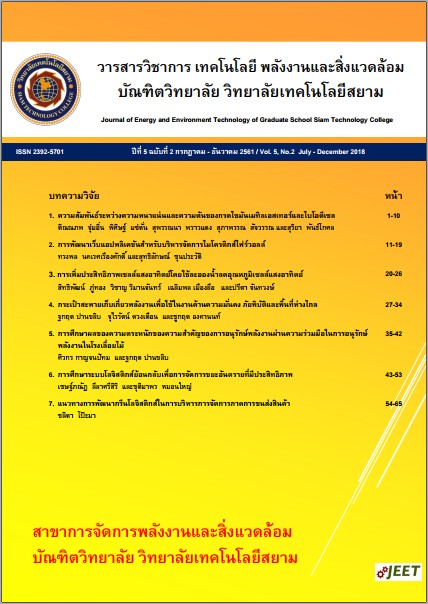The development of green logistics management in the transport sector
Main Article Content
Abstract
This research aims to develop guidelines for green logistics management in the cargo sector and its return(backhaul). Using mathematical modeling. And find the right answer through a program for a reasonable fee. And how to pick the right product. The cargo area in the southern province where 45 percent of the province. Krabi, Nakhon Si Thammarat, Narathiwat, and the resulting transportation costs are high. And used a lot. Making the company cannot control the car to run back empty. And the cost of car sharing. The company makes cost a long way back. The researchers solved the problem by creating a mathematical model. The new transportation management plan for the Southern District. To keep costs low by most. And the number of car sharing to a minimum. The mathematical model is built. Considering the freight management for a company case study, which has toured the ship and return. The original form of transport direct to the customer needs to make a transit occurs when a company case study conducted jointly arrange transportation to the point of origin immediately. This format, which makes transportation costs are high. And used a lot. So the solution using a general linear programming problem of transit through.
The experimental results showed that the original form of transportation cost is 588,000 baht and used cars, 20 cars compared to modes of transportation that can be used empty. And consolidation costs of transport are at 380,000 baht to save costs by up to 35 percent and the number of cars featured 12 cars, reducing the number of car share to 60 percent and reduces energy by up to 60 percent. The number of car-share decline. The results of this study It can be applied to the transportation of other case studies that are similar transport.
Article Details
เนื้อหาและข่อมูลในบทความที่ลงตีพิมพ์ในวารสารวิชาการ เทคโนโลยี พลังงาน และสิ่งแวดล้อม บัณฑิตวิทยาลัย วิทยาลัยเทคโนโลยีสยาม ถือเป็นข้อคิดเห็นและความรับผิดชอบของผู้เขียนบทความโดยตรง ซึ่งกองบรรณาธิการวารสารไม่จำเป็นต้องเห็นด้วย หรือว่าร่วมรับผิดชอบใด ๆ
บทความ ข้อมูล เนื้อหา รูปภาพ ฯลฯ ที่ได้รับการตีพิมพ์ในวารสารวิชาการ เทคโนโลยี พลังงาน และสิ่งแวดล้อม บัณฑิตวิทยาลัย วิทยาลัยเทคโนโลยีสยาม ถือเป็นลิขสิทธิ์ของวารสารวิชาการ เทคโนโลยี พลังงาน และสิ่งแวดล้อม บัณฑิตวิทยาลัย วิทยาลัยเทคโนโลยีสยาม หากบุคคล หรือหน่วยงานใดต้องการนำทั้งหมด หรือส่วนหนึ่งส่วนใดไปเผยแพร่ต่อ หรือเพื่อกระทำการใด ๆ จะต้องได้รับอนุญาต เป็นลายลักษณ์อักษรจากวารสารวิชาการ เทคโนโลยี พลังงาน และสิ่งแวดล้อม บัณฑิตวิทยาลัย วิทยาลัยเทคโนโลยีสยาม เท่านั้น
References
[2] ขวัญฤดี โชติชนาทวีวงศ์. 2557. วารสารธุรกิจสีเขียว. 8(1).
[3] รพงศ์ พงศ์ดำรงศักดา และสุนาริน จันทะ. 2560. การกำหนดตำแหน่งฐานปล่อยรถบรรทุกโดยพิจารณาปริมาณสินค้าที่บรรทุก ทั้งเที่ยวไปและกลับ กรณีศึกษาผู้ให้บริการด้านโลจิสติกส์.
[4] มนัส บุญวงศ์ และมาเรียม นะมิ. 2557. ปัจจัยที่มีอิทธิพลต่อการพัฒนาศักยภาพผู้ให้บริการด้านการขนส่งนักท่องเที่ยวด้วยความเป็นมิตรกับสิ่งแวดล้อมเพื่อรองรับการเปิดเส้นทางโลจิสติกส์อาเซียน. มหาวิทยาลัยเทคโนโลยีราชมงคลพระนคร.
[5] วลัยลักษณ์ อัตธีรวงศ์ และวริยา ปานปรุง. 2559. แรงขับเคลื่อนในการประยุกต์ใช้การจัดการโลจิสติกส์สีเขียวสำหรับผู้ประกอบการหนึ่งตำบลหนึ่งผลิตภัณฑ์. วารสารวิทยาศาสตร์และเทคโนโลยี. 24(2).
[6] อัณยา ประเสริฐลาภ. 2558. การนำแนวคิดกรีนซัพพลายเชนมาประยุกต์ใช้เพื่อเพิ่มคุณภาพสิ่งแวดล้อมภายในบริษัทในการจัดการให้มีประสิทธิภาพ. วิทยาศาสตรมหาบัณฑิต. มหาวิทยาลัยบูรพา.
[7] ศิริพร เลิศยิ่งยศ วิโรจน์ เจษฎาลักษณ์ และจันทนา แสนสุข. 2558. ความสามารถการจัดการโลจิสติกส์สีเขียวที่มีผลต่อการตอบสนองความต้องการของผู้มีส่วนได้เสีย และผลการดำเนินงานของอุตสาหกรรมกระดาษในประเทศไทย. วารสารบริหารธุรกิจ. 38(147). มหาวิทยาลัยธรรมศาสตร์.
[8] Rommert Dekker Jacqueline Bloemhof Ioannis Mallidis. 2012. Operations Research for green logistics – An overview of aspects, issues, contributions and challenges. European Journal of Operational Research. 219(3), pp 671-679.
[9] Hokey Min & Ilsuk Kim. 2012. Green supply chain research: past, present, and future. Logistics Research. March 2012, 4(1–2), pp 39–47.


